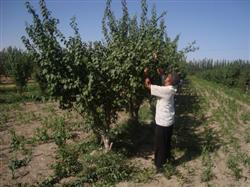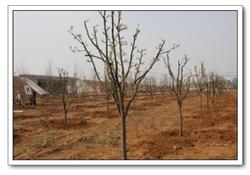How to cut apricot trees in winter?
Winter pruning can regulate the relationship between vegetative growth and reproductive growth, determine a reasonable load, overcome the size of the year, and prolong the life span of apricot trees. The pruning methods and strategies of apricot trees are different in different periods. The following pruning methods are often adopted in production practice. The main results are as follows: 1. in winter pruning young and early fruit trees, apricot trees generally grow vigorously, the crown expands rapidly, the growth of new shoots is large, and the second and third branches are often produced. This period of pruning should take into account both plastic surgery and results. The elongated branches of the main and lateral branches should be cut and put lightly, and the length of the whole branch should be cut short by 2% of the total branch. Remove dense squeezed branches, multi-branched branches, overlapping branches and strong branches of disordered tree type, and control the growth of competitive branches and erect branches. The developing branches with moderate growth and relatively open angle should be released slowly, promote the germination of medium and short branches, increase the number of fruiting branches, and retract and culture into fruiting branches in time after flowering or fruiting. Medium and short branches have a large angle and are easy to form flowers, so they should be retained as far as possible in order to bear fruit. Young trees with weak growth should be properly truncated, too dense, thin and weak branches should be thinned, strong branches should be retained, and strong branches should be flattened as auxiliary branches to promote the development of sturdy medium and short fruit branches. Second, the winter pruning and shaping of apricot trees in full fruiting period has been basically completed. With the increase of tree age, the yield increases steadily, the growth potential weakens, and the tree potential becomes more and more relaxed. The main task of the pruning period is to adjust the relationship between growth and fruit, maintain the tree potential and prolong the fruiting years of the full fruiting period. during pruning, the tree can be properly thinned and cut off according to the growth of branches and the spatial conditions of various parts of the crown, so as to maintain a stable fruiting position and growth potential. Lengthening branches at all levels are generally moderately cut so that they can continue to produce healthy new branches. The weak main branch, side branch, perennial auxiliary branch, fruiting branch group and drooping branch were retracted and renewed or raised in the place where there were strong branches to restore their growth potential. For the lower part of the crown and the inner bore branches, we should pay attention to timely renewal and rejuvenation, so that they continue to produce new robust fruiting branches. The over-dense branches and strong branches in the upper and outer parts of the crown were retracted or thinned to improve the inner chamber light. Apricot branch formation ability is weak, for each part of the fruiting branch group, long fruit branch and moderately growing branches, as long as it is not too dense, generally do not remove, can cut short a small number of long branches, so that the middle and lower parts of the medium and short branches bear fruit alternately. Third, the winter pruning of apricot trees in winter, the growth of the extended branches of apricot trees was weak, the new shoots were short, the backbone branches began to droop, the interior of the crown began to be bald, and the yield decreased almost only on the surface of the crown. The task of pruning is to renew the backbone branch group, enhance the tree potential and prolong the fruiting life. The upper dorsal branches with small angle and strong growth in the middle and lower part are used to change the head. for the overgrown branches in the proper position, they should be cultured into backbone branches and fruiting branches. For the fruiting branch group and fruiting branch, in accordance with the principle of "removing the weak and staying strong", the strong branches and buds were selected for renewal and pruning to restore and maintain the yield.
- Prev

Five key points in the management of apricot trees after unloading fruit
First, thinning branches to remove the new apricot heads sprouting from the overdense perennial branches and backbone branches. Branches are evacuated and red apricots are full; branches are crowded and hanging is empty. Therefore, those who are in the wrong position and do not plan to be reserved for use as regeneration branches should be removed as soon as possible. Second, to pick the heart is to cut off the buds at the top of the apricot head. Usually take it off.
- Next

Measures for fertilizer and water management of apricot trees
The main results are as follows: 1. fertilizing young trees in the first year of planting, applying fertilizer with thin application, in order to rapidly expand the crown and form a certain number of flower buds. The first fertilizer was applied when it sprouted after planting, and then topdressing once every 15 ~ 20 days, mainly urea, combined with phosphorus, potash and organic fertilizer. Stop topdressing at the beginning of July and control it properly.
Related
- Moge, come on! The staff of the peasant association in the producing area of cantaloupe were frightened when the crowd gathered.
- Causes and Solutions of low Fruit setting rate of Apple
- Symptoms and control measures of passion fruit virus disease
- Fruit growing lesson: how do apple orchards keep high yields?
- Can you build orchards in the mountains? What are the pros and cons?
- How to manage the coloring period of Crisson grape?
- This paper introduces the processing technology of two kinds of fig products.
- How much is a month for retired teachers in rural areas by 2020?
- How can strawberry planting increase sugar content? We should pay attention to management in many aspects.
- What are the cultivation techniques on how to improve the yield of golden fruit?

